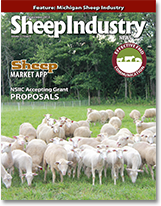To View the December 2013 Digial Issue — Click Here
Working Together to Market Lambs
Clint Krebs, ASI President
I was driving through the “nearest town” with a livestock auction, and because it was sale day and the rain interrupted my haying, I decided to stop in for the sheep sale. I ended up bringing home a truck load of very high-quality feeder lambs. Now for my confession, I paid a ridiculously low price for the kind of lambs the owners had worked hard to raise. I know those producers were very disappointed in the price they received for the hard work and care they provided to raise these lambs. So I ask you, how did this happen, or why does it happen in other parts of the country at different times.
I first thought of the producer. Why were these lambs brought to the sale: 1. Because they were out of feed; 2. Because they weighed 100 pounds and the producer thought they were ready to be harvested; 3. Because the predators were killing so many they wanted to sell what was still alive; or 4. They were tired of putting them back in the pasture every night.
If you answered yes to any solution except No. 2, I agree it was a good time to sell. However a 100-pound lamb is not ready to be commercially harvested in the U.S. market. In all likelihood, it will be sold as a feeder lamb in most auction barns. I know most of the rest of the sheep producers around the world harvest lambs in this window (100 pounds); HOWEVER, “American Lamb” just like “American Beef ” is not the same. So if the owners of the lambs, which were at the auction, brought them in because they thought they should have been harvested, they were wrong. Yes, they could have been harvested and provide a good eating experience for the consumer; however, that isn’t going to happen in today’s commercial industry.
If the producer brought them for sale at my local auction for any of the other three reasons, all I can say is: I wished the price of corn wasn’t so high and I could have paid more for the lambs. My message to producers is: Plan your marketing for the time period when demand is high for your type of lambs. Talk to your buyer, be it an auction yard, a feeder or a processor. Find out when there is an opportunity to get a price for your lambs that is higher than the cost of producing them.
I brought this load of lambs home and put them in with some ewes and lambs that I have under a four wire fence. I had just received 2.75 inches of rain and my pasture looked like a lawn; however, right now I am questioning my decision as all my neighbors are calling to tell me my sheep are out. I explained to them, my wife and dog Roy are in the process of getting them back in, but Roy is getting old and he is not quite as good as he used to be. But both he and my wife are working as fast as they can. My point is that we all have a part to do in balancing out the supply of lambs in the U.S. marketplace in order to get the price of live lambs above the cost of producing them. The producers need to think about when to market the lambs or when to lamb their ewes. The lamb feeders need to think about something other than corn and use green pastures if they can. Maybe the processors need to think about freezing or exporting some high-quality American lamb by selling the meat we are producing in different markets. I really believe there are things we can do to bring up these low prices, but all segments have to work together.
For now, I had better go help my wife before she runs into one of the neighbors I have been talking about.


